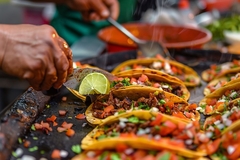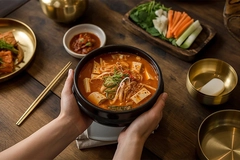
- Industry news
Industry news
- Category news
Category news
- Reports
- Key trends
- Multimedia
- Journal
- Events
- Suppliers
- Home
- Industry news
Industry news
- Category news
Category news
- Reports
- Key trends
- Multimedia
- Events
- Suppliers
Givaudan: Capitalizing on hot demand for Latin American flavors in the US
Key takeaways
- Over half of US consumers are drawn to Latin American flavors, signaling strong growth potential for new Latin-inspired products.
- Lesser-known ingredients like epazote and achiote offer creative opportunities, but success depends on authenticity and cultural respect.
- Latin flavors attract all age groups — pairing familiar formats with new twists helps engage both adventurous and cautious consumers.

Ongoing consumer research from Givaudan Taste & Wellbeing reveals what the company says is a significant and growing opportunity for brands to target US consumers with Latin American flavor innovation. In a national survey exploring awareness, interest, and the use of Latin-inspired ingredients, a majority of consumers expressed an active interest in new and novel ingredients.
Sixty-six percent said they pursue globally inspired flavors. Within that group, 76% are specifically drawn to Latin American offerings, representing about 54% of the general population. That scale of engagement, Givaudan says, highlights the critical appeal of familiar Latin flavors and the potential for new products and ingredients.
Mainstream ingredients such as cinnamon, chili powder, and cumin remain widely recognized, while lesser-known spices like epazote, achiote, and culantro have the potential for innovation.
Sauces such as aji verde, chimichurri, and mole poblano emerge as leading flavor “ambassadors,” signaling that authenticity-driven, restaurant-inspired formats could bridge the next wave of product development.
Food Ingredients First sits down with Givaudan’s category manager, Kelsey Roden, and head of consumer insights, Kim Duncan, to discuss what’s driving this surge in interest, how brands can bridge gaps in familiarity, and where the most promising innovation opportunities lie.
Momentum behind Latin American flavors
The data shows that Latin American flavors are no longer niche. They’ve become a gateway for consumers, reflecting how these cuisines have gradually entered the mainstream through local restaurants and national retailers.
 Kelsey Roden, savory category marketing manager for North America at Givaudan.“Over the past 3–5 years, we’ve seen a big rise in globally inspired cuisine across food and beverage, including more regional Latin foodservice operators popping up across the country,” says Roden.
Kelsey Roden, savory category marketing manager for North America at Givaudan.“Over the past 3–5 years, we’ve seen a big rise in globally inspired cuisine across food and beverage, including more regional Latin foodservice operators popping up across the country,” says Roden.
“When we notice a trend making waves both in packaged goods and foodservice, it’s a strong sign we should dig deeper to understand the details and nuances. That way, we can help our customers create, or enhance, products that really deliver on what consumers are looking for, backed by Givaudan’s global insights and regional expertise.”
Cross-generational appeal
Interest in Latin flavors spans age groups, with particular enthusiasm among those aged 35–54 and 18–34, the survey shows. Duncan points to exposure and familiarity as key factors.
“For the 35–54 crowd in the US, a lot of this goes back to exposure over the years,” says Duncan. “Many were exposed to Mexican foods through American chains. Then, more local and regionally owned Mexican restaurants started showing up, which was a natural fit for people who already loved these types of foods.”
“For younger consumers today, these same options are still accessible, and many of them were introduced to the flavors by parents who already loved Mexican cuisine. It makes sense that this type of food resonates across generations.”
Comfort to curiosity
The research highlights the potential for lesser-known and new ingredients to have a market impact in the US. Duncan says the opportunity lies in making those ingredients accessible to all consumers.
“When it comes to less familiar spices like epazote or culantro, the key is to make them approachable,” she says. “One way to do that is by adding a short flavor description right on the menu or packaging. Instead of just saying ‘Lime Culantro Rice,’ say ‘Lime Culantro Rice — culantro adds an extra-bold flavor.’ Pairing those spices with familiar ingredients gives consumers a safety net.”
When marketing products, it’s critical that brands know whether their target audience is more adventurous or more conservative, she emphasizes.
“For adventurous consumers, you have more freedom to play with unfamiliar flavors. For ‘hesitators,’ you’ll need to ease them in with more familiar combinations. There’s no one-size-fits-all approach anymore.”
Authenticity and formats
Flavor experiences also differ by format. Duncan explains how consumer expectations shift between restaurant dining and packaged meals.
“For restaurants and retail formats, convenience and time-saving are big drivers,” she says.
“Restaurants, though, have a strong edge when it comes to authenticity, and that’s why people choose them. Frozen or ready-to-eat meals, on the other hand, tend to win on price and convenience. This is why Givaudan partners with brands to recreate that restaurant-level flavor experience in packaged formats, ensuring we deliver on taste, freshness, and cultural authenticity even at shelf-stable or frozen stages.”
Culture and transparency
As brands explore Latin-inspired innovation, Roden underscores the importance of cultural respect and transparency.
 Kim Duncan, head of consumer insights for Taste & Wellbeing at Givaudan.“Before launching Latin-inspired products, brands should ask: Do we have a right to play here? Will consumers see this as authentic?” says Roden.
Kim Duncan, head of consumer insights for Taste & Wellbeing at Givaudan.“Before launching Latin-inspired products, brands should ask: Do we have a right to play here? Will consumers see this as authentic?” says Roden.
“True authenticity goes beyond simply following a trend, as it’s about offering ongoing efforts and commitment to honoring the heritage, culture, and traditions behind each dish. That means using the right ingredients, telling the stories behind them, and ensuring genuine representation.”
“US consumers are craving fresh tastes, exciting textures, and new food adventures, and Latin American cuisine delivers on all of that. It’s packed with rich stories, irresistible ingredients, and so many ways to get creative. Think street-food-style sauces, vibrant tropical drinks, and flavor combinations that surprise and delight.”
Givaudan aims to help brands bring these ideas to life in a way that feels real, celebrates the culture behind them, and leaves consumers coming back for more, she adds.
Looking ahead: Regional nuance and opportunity
The study reflects a broader shift toward specificity and story-driven exploration, comments Roden, adding that regional detail will be the defining factor in the next phase of innovation.
“People want to know if a particular flavor is inspired by a particular city, region, or even neighborhood. Consumers already love well-known favorites like birria tacos. But there’s an exciting opportunity to take a familiar ‘format,’ like a taco, and add unexpected regional twists, such as a bold sauce or a unique spice blend, to give consumers something that feels both familiar and fresh. It’s a way to surprise and delight without straying too far from what they know,” she says.
Roden continues that Givaudan can leverage its consumer insight tools, global culinary network, and full spectrum of flavor, taste, and product development expertise to help brands anticipate and capitalize on emerging flavor trends.
“Latin American flavors continue to thrive because they blend rich cultural roots with opportunities for creative reinvention, as they offer something intriguing for flavor-seekers while remaining accessible to more cautious consumers. Success lies in understanding audience mindsets, pairing the familiar with the novel, and honoring authentic heritage in both taste and storytelling.”
















